![]()
![]()
![]()
Use LEFT and RIGHT arrow keys to navigate between flashcards;
Use UP and DOWN arrow keys to flip the card;
H to show hint;
A reads text to speech;
152 Cards in this Set
- Front
- Back
|
What is the first line of defense?
|
body coverings such as mucus membranes, skin, etc.
|
|
|
What is the second line of defense?
|
phagocytic cells
|
|
|
What is another name for the specific immune system?
|
adaptive immune response
|
|
|
What is the third line of defense?
|
specific immune system/ adaptive immune response
|
|
|
What is the most important non-specific DM?
|
intact skin
|
|
|
What makes skin such a great defensive mechanism?
|
keratin, dry, slightly acidic, oil, contains chemicals that inhibit bacteria, and perspiration
|
|
|
What is bacteriolytic lysozymes?
|
proteins that eat bacteria
|
|
|
What is defensin and where is it commonly found?
|
a protein that pokes holes in bacteria cell membranes - mucous membranes
|
|
|
What is transferrin and where is it found?
|
a protein that binds to free Fe so pathogens cannot - blood
|
|
|
What is lactoferrin and where is it found?
|
a protein that binds to free Fe so pathogens cannot - mother's milk
|
|
|
What are the steps in phagocytosis?
|
chemotaxis, diapedisis, adherence, engulf
|
|
|
What do phagocytes eat?
|
antigen antibody complex
|
|
|
How do killer cells rid the body of what is hurting it?
|
chemicals
|
|
|
Define inflammation.
|
homeostatic response to tissue damage, functions in cleaning the damge site so tissue repair can occur
|
|
|
How is pus carried away?
|
blood
|
|
|
What is interferon?
|
a protein that is made by lymphocytes when they produce baby viruses. If the interferon makes it to the new cell before the virus then it prevents the cell from making new viruses
|
|
|
What is complement?
|
a protein that binds to foreign cells and targets them for phagocytosis
|
|
|
Define opsonization.
|
a process that enhances phagocytosis
|
|
|
Define cytolysis.
|
When compliment attaches to a cell it pokes holes in the membrane
|
|
|
Define cytokines.
|
chemicals produced by certain types of cells and then go to different cells and deliver a message
|
|
|
Define normal flora.
|
microbes that live in you and on you all the time. These won't allow new microbes to come in a set up residence
|
|
|
The immune system has 3 important properties, what are they?
|
specifity, systemic, once you have it, it has memory
|
|
|
What are the two types of immune responses?
|
cellular or cell mediate immunity and antibody mediate immunity or humoral immunity
|
|
|
In cellular mediated immunity what is the cell called that actually does the killing?
|
cytotoxic T cell
|
|
|
What does cell mediated immunity typically protect you against?
|
intracellular attacks
|
|
|
What does antibody mediated immunity or humoral immunity typically protect you against?
|
extracellular attacks
|
|
|
What happens in antibody mediated/humoral immunity?
|
b cells first become plasma cells which secrete proteins called antibodies that complex with bacteria, virus, or bacterial toxin and targets them for phagocytosis
|
|
|
Define an antigen.
|
any substance that when inject into an organism causes an immune response
|
|
|
What two properties do complete antigens have?
|
immunogenicity and reactivity
|
|
|
Define immunogenicity.
|
ability of an antigen to stimulate an immune response
|
|
|
Define reactivity.
|
the ability of an antigen to react with a preformed antibody or sensitized T cell
|
|
|
What do you use as antigens?
|
proteins or lippo proteins or in some cases polysaccharides
|
|
|
What chemicals have no ability to be sensed by the immune system?
|
stainless steel and plastic polymers
|
|
|
Define an epitope.
|
part of the antigen that the immune system sees
|
|
|
Define hapten.
|
a molecule that is too small for immonogenticy but it will react with a preformed antibody or a sensitized T cells
|
|
|
Define major histocompatibilty complex antigens.
|
glycoproteins found on all cell membranes except RBCs that mark your cells as yours
|
|
|
What are MHCs that are found on WBC?
|
HLA - human leukocyte antigen
|
|
|
What is responsible for organ rejection?
|
MHC - major histocompatibility complex
|
|
|
Define immunilogic tolerance.
|
a specific unresponsiveness to an antigen
|
|
|
How did T cells come about?
|
derived from Thymus gland
|
|
|
How do B cells come about?
|
derived from Bone marrow
|
|
|
Define immunocompetence.
|
the ability of an immune system cell to recognize and respone to a specific antigen
|
|
|
Why types of cells carry out antigen processing?
|
machrophages, dendritic cells, and activated B cells
|
|
|
What are the steps of antigen processing?
|
cells located at entry points for pathogens, carry out phagocytosis, eats a pathogen and places epitope on membrane, takes epitope to B cell and complexes with it
|
|
|
Define cross reaction.
|
a specific antibody that is able to react with more than one antigen
|
|
|
Define antigenic challenge.
|
very first encounter between an antigen and your immune system
|
|
|
Where does antigenic challenge usually occur?
|
most frequently in spleen or lymph nodes
|
|
|
In the antigenic challenge what is the function of a B cell?
|
clones and divided those cloned cells into two different groups, plasma and memory B cells
|
|
|
What is the function of the plasma cell in an antigenic challenge?
|
produce identical antibodies so the antigen will complex with it
|
|
|
What is the function of memory B cell in an antigenic challenge?
|
responsible for long term protection and these are th ones that protect from subsequent attacks later on in life
|
|
|
What is the legal name for antibodies?
|
immunoglobulins
|
|
|
Antibodies are in what group?
|
group of plasma proteins in the group of globulins
|
|
|
What are the long chains of antibodies called?
|
heavy
|
|
|
What are the short chains of antibodies called?
|
light
|
|
|
What are the two regions on the peptide chains on antibodies called?
|
ends are variable, the rest is constant
|
|
|
How many classes of antibodies are there?
|
5
|
|
|
What is the class of antibodies that is in the greatest amount?
|
IgG
|
|
|
What is the function of IgG?
|
opsonization and fixing complement
|
|
|
What is the class of antibodies that crosses the placenta wall?
|
IgG
|
|
|
When do you develop IgG antibodies?
|
when you are exposed to the antigen
|
|
|
How many sets of polypeptide chains does IgM have?
|
5
|
|
|
What is the first antibody that baby's system begins to make?
|
IgM
|
|
|
When is the only time IgM is produced?
|
during your first exposure
|
|
|
What antibody is used to date infection?
|
IgM
|
|
|
What antibody decreases in numbers when you get stressed out?
|
IgA
|
|
|
Where can IgA be found?
|
blood, lymph, mucous membrane, tears, saliva, secretions of GI tube, mother's milk
|
|
|
What is the function of IgA in mucous membranes?
|
it is lying in wait in places where microbes frequently enter the body and busts them up
|
|
|
What antibody functions as the receptor site of the antigen for B cells?
|
IgD
|
|
|
What antibody can be found on membrane of mast cells?
|
IgE
|
|
|
What is a monoclonal antibody?
|
hybridoma
|
|
|
What is a hybridoma?
|
cross between a plasma cell and a cancer cell
|
|
|
What are the 2 major types of T cells?
|
killer or cytotoxic T cells and helper T cells
|
|
|
What is the function of killer or cytotoxic T cells?
|
responsible for destroying foreign antigens
|
|
|
What is the function of helper T cells?
|
help to intensify immune system responses
|
|
|
Who secretes cytokine and what function does it have?
|
Helper T cells > tells the activated B or T cell to divide
|
|
|
What is the function of suppressor or regulatory T cell?
|
functions to reduce an immune response when you no longer need the protection at such an intensity
|
|
|
which type of T cell is responsible for immunologic tolerance?
|
suppressor/regulatory T cell
|
|
|
How do special killer T cells attack the problem?
|
secrete a chemical that tell machrophages to go and eat the problem
|
|
|
What is another name for special killer T cells?
|
delayed hypersensitivity T cells
|
|
|
What is another name for delayed hypersenstitivity T cells?
|
special killer T cells
|
|
|
What antibody is responsible for immunologic memory?
|
IgG
|
|
|
Concerning B cells in immunologic memory what happens during a subsequent response?
|
memory B cells respond more quickly and more intensely
|
|
|
What are the other names for subsequent response?
|
secondary or anamnestic response
|
|
|
Define naturally acquired active immunity.
|
first exposure to the pathogen was in the form of an infection - produce IgG and memory B cells and therefore lifelong protections
|
|
|
Define artificially acquired active immunity?
|
first exposure to the pathogen was from a vaccine - produces IgG and memory B cells and therefore lifelong protection
|
|
|
Define naturally acquired passive immunity.
|
transfer of IgG from mom to fetus across placenta - only IgG crosses and after a couple of month the protein is broken down to amino acids
|
|
|
Define artificially acquired passive immunity.
|
involves the use of gamma globulin therapy, which is where you receive a dose of a certain IgG
|
|
|
What is the route of lymph flow through a lymph node?
|
subcapsular sinus, trabecular sinus, medullary sinus, efferent lymphatic vessel
|
|
|
What cell makes and secretes an antibody?
|
plasma cell
|
|
|
What cell is necessary for your long term protection?
|
memory B cells
|
|

Label
|
A: left renal
B: inferior mesenteric C: inferior vena cava |
|
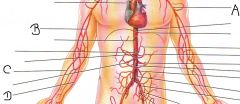
Label
|
A: left axillary
B: right brachial C: right radial D: right ulnar |
|

Label
|
A: right subclavian
B: brachiocephalic trunk C: left subclavian |
|
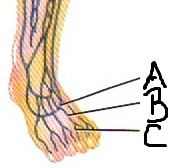
Label
|
A: left dorsal venous arch
B: left dorsal metatarsal C: left dorsal digital |
|
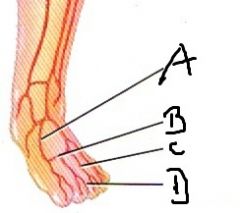
Label
|
A: left dorsal artery of foot
B: left arcuate C: left dorsal metatarsal D: left dorsal digital |
|

Label
|
A: Right deep palmar arch
B: Right superficial palmar arch C: Left common palmar digital D: Left proper palmar digital |
|
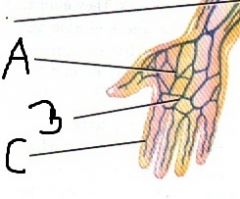
Label
|
A: Right palmar venous plexus
B: Right palmar digital C: Right proper palmar digital |
|
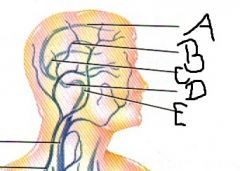
Label
|
A: Superior sagittal sinus
B: Inferior sagittal sinus C: Straight sinus D: Right transverse sinus E: Sigmoid sinus |
|

Label
|
A: Superior vena cava
B: Pulmonary trunk C: Coronary sinus D: Great cardiac |
|
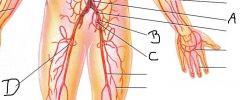
Label
|
A: Inferior mesenteric
B: Left external iliac C: Left internal iliac D: Right deep femoral |
|
|
Label
|
A: Left common iliac
B: Left internal iliac C: Left external iliac |
|

Label
|
A: Left common iliac
B: Left internal iliac C: Left external iliac |
|
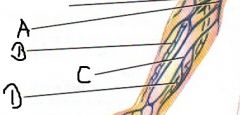
Label
|
A: Right basilic
B: Right radial C: Right median antebrachial D: Right ulnar |
|
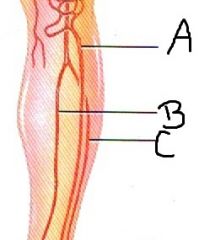
Label
|
A: Left anterior tibial
B: Left posterior tibial C: Left fibular |
|
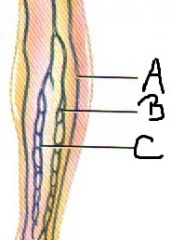
Label
|
A: Left small saphenous
B: Left anterior tibial C: Left posterior tibial |
|

Label
|
A: Right internal jugular
B: Right external jugular C: Right subclavian D: Right brachiocephalic |
|

Label
|
A: Right internal carotid
B: Right vertebral C: Right common carotid D: Right external carotid E: Left common carotid |
|

Label
|
A: Thoracic aorta
B: Abdominal aorta C: Celiac trunk D: Common hepatic |
|

Label
|
A: Right hepatic
B: Hepatic portal C: Splenic D: Superior mesenteric |
|

Label
|
A: Left gastric
B: Splenic C: Left renal D: Superior mesenteric E: Left gonadal |
|

Label
|
A: Right axillary
B: Right cephalic C: Right brachial D: Right median cubital |
|
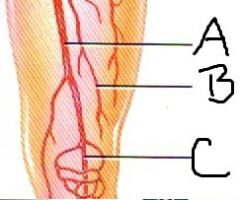
Label
|
A: Left femoral
B: Left deep femoral C: Left popliteal |
|
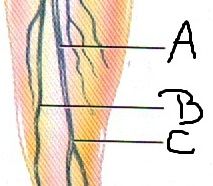
Label
|
A: Left femoral
B: Left great saphenous C: Left popliteal |
|
|
What immune cells are found in humoral immunity?
|
B cells
|
|
|
What immune cells are found in antibody mediated immunity?
|
B cells
|
|
|
What immune cells are found in cellular immunity?
|
T cells
|
|
|
Is gamma globulin therapy long or short term treatment?
|
short
|
|
|
Define a vaccine.
|
a suspension of antigen that when injected into an individual stimulates an immune response
|
|
|
What is interferron?
|
an antiviral protein made by cells in you such as machrophages, fibroblasts, lymphocytes
|
|
|
Define an attenuated vaccine.
|
microbe is alive, but has been altered so it can't make the recipient sick
|
|
|
Define a toxoid vaccine.
|
take the toxin from the bacteria so that it can't hurt you
|
|
|
What are the three types of vaccines?
|
killed whole cell, attenuated, toxoid
|
|
|
Define a microbial component vaccine.
|
a vaccine where they only use the epitope of the pathogen
|
|
|
What is the vaccine where they only use the epitope of the pathogen?
|
microbial component
|
|
|
What Igs do you develop from attenuated vaccines?
|
IgA and IgG
|
|
|
Which vaccine is life long?
|
attenuated
|
|
|
What is the function of herd immunity?
|
prevents those who have gotten the vaccine and it didn't take are still protected because those around them cannot get the sickness
|
|
|
What happens when a cell decides to become cancerous?
|
cell divides like crazy and MHC marker changes making the cell a foreign cell
|
|
|
Why do people still get cancer?
|
MHC doesn't change enought for cytotoxic cell to recognize it to attack and sometimes people's T cells aren't quite strong enough to beat the cancer
|
|
|
If a person't T cells aren't strong enough to conquer cancer cells what do scientists do to the T cells?
|
take them out of the body,m make them stronger, and inject them back into the patient
|
|
|
Define autograft.
|
donor is the recipient, transplant from one part of body to another
|
|
|
What type of transplant is the best?
|
autograft
|
|
|
Define isograft.
|
transplant between identical twins therefore MHC is the same
|
|
|
Define allograft.
|
transplant between genetically different individuals of the same species
|
|
|
What is the most common transplant?
|
allograft
|
|
|
When a person receives an allograft what do they need to take so they do not reject the organ?
|
immunosuppressients
|
|
|
How long does an organ receiver have to take immunosuppressients?
|
forever
|
|
|
Define a xenograft.
|
transplant between species
|
|
|
What is graft vs. host disease?
|
donated organ mount an immune attack against the recipient, usually fatal
|
|
|
Define immunodeficiencies.
|
the individual's immune system cannot either produce or maintain an immune response
|
|
|
What is the sign of an immunodeficiency?
|
repeated infections
|
|
|
What is a primary or congenital immunodeficiency?
|
when someone is born with an immunodeficiency
|
|
|
What is a secondary or acquired immunodeficiency?
|
a person develops an immunodeficiency
|
|
|
How can someone develop an immunodeficiency?
|
malnutrition, cancer, infection
|
|
|
Define autoimmune diseases.
|
the body looses the ability to discriminate between self and non-self, antibodies destroy self antigens
|
|
|
Define a hypersensitivity reaction.
|
usually an allergy reaction, results when the immune system causes tissue damage, immune system responds to an antigen it doesn't need to
|
|
|
What are the four types of hypersensitivity reactions?
|
Type 1: immediate
Type 2: cytotoxic Type 3: immune complex Type 4: delayed or cell mediated |
|
|
Which type of hypersensitivity reaction has no symptoms the first exposure?
|
Type 1 immediate
|
|
|
What happens during type1 immediate hypersensitivity reactions.
|
B cells make IgE and binds to cell membrane of a mast cell and histamine is released
|
|
|
What happens in a type 2 cytotoxic hypersensitivity reaction?
|
antigen is on cell membrane in insoluble and antibody is soluble so when there is an antigen-antibody complex the cell breaks down ex: clumping in blood
|
|
|
What happens in type 3 immune complex hypersensitivity reaction?
|
antigen-antibody complexes produce too fast and phagocytic cells cannot keep up causing inflammation
|
|
|
What happens in type 4 delayed or cell mediated hypersensitivity reactions?
|
T cells attack but it takes a while ex: cancers, poison ivy, nickel in soaps
|

